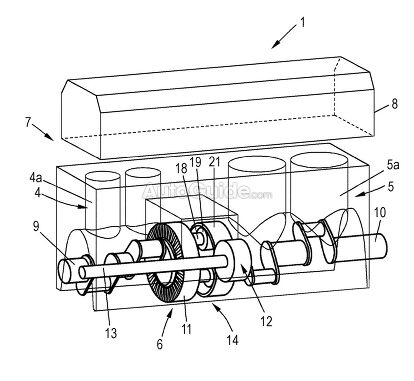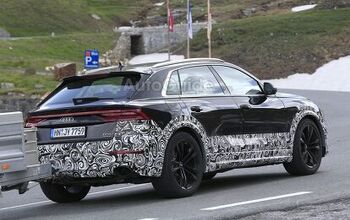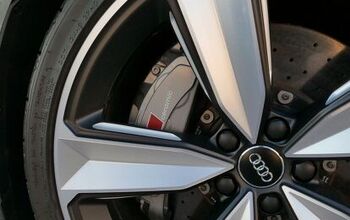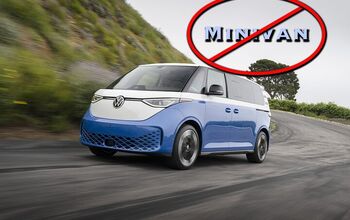How Audi Wants to Squeeze Two Engines Into One Block

A recent patent application from Audi reveals the German automaker is working on something very interesting.
Since the ’60s, there have been efforts to get turbine engines into cars, but it never seems to stick. Why? Well, among other things, they tend not to be very efficient at getting cars up to speed. Turbines would be great on the highway, but terrible in town. Their focus is too narrow.
The thing is, though, piston engines aren’t necessarily good in every part of their rpm range, either. That’s why there are so many different kinds of them. Engines on sale today have a range of displacements that vary from 660 cc (in the Caterham Seven 160) to more than 10 times that in the 8,000 cc (in the Bugatti Chiron). But what if you could have a small efficient engine for maintaining speed and a big meaty engine for acceleration?
That’s what Audi’s working on right now, as patent files reveal that the Ingolstadters want to effectively squeeze two separate engines into one engine block. As per the patent drawings, that would mean an engine with two cylinder displacing, say, 1,000 cc, and another two, bigger cylinder, displacing 1,500 cc–though this is anything but the only possible arrangement.
According to the patent filings, the two sets of cylinders could run independently of one another or in sync depending on what’s most efficient. It could even run with an electric motor, as well, in order to smooth out any efficiency gaps.
The system would allow engineers to design cars with varying displacement. Audi is far from the only automaker working on expanding the usefulness of engines thusly. Inifiniti recently put an engine with variable compression ratios on the market, which allows its engines to change based on what’s needed of it. So it can be powerful or efficient.
Similarly, many engines can shut down cylinders to turn a V8 into a V4 when the power requirements don’t necessitate feeding all eight cylinders with fuel.
SEE ALSO: Audi E-Tron to Offer Digital Side View Mirrors
But those systems all work with one crankshaft–the thing the pistons are actually turning that gets power to the wheels–meaning that when full displacement isn’t being used, there’s still a lot of metal flopping around, being heavy. In the case of the cylinder deactivation technology, for instance, the pistons that are “deactivated” are still going up and down in the cylinder, they just aren’t getting fuel or spark to create an explosion.
In Audi’s case, the unused pistons don’t need to turn at all because their crankshaft is consciously uncoupled from the rest of the engine, and indeed car, like Gwyneth Paltrow. That makes the work of the other pistons easier, because they don’t have a lot of useless pistons to move around. Whereas cylinder deactivation is like having children, Audi’s twin engine system is like having nieces and nephews. They’re there when you miss them, but they aren’t a drag when you don’t.
And getting those nieces and nephews to pitch in again won’t be hard for Audi, because it’s already working on actively shutting down your engine. Coasting technology allows its cars to, well, coast with the engine completely off. A bit like engaging your clutch, but better because instead of idling (which is less efficient than you’d think) the engine quietly stops running altogether and comes back on when it’s needed again.
Audi can manage this thanks to its newfangled 48-volt technology that allows for all manner of wonderful electrical assists, like turbos that don’t need time to spool up.
The obvious problem with this twin-engine system is, of course, weight. A crankshaft decoupler is presumably a heavy, complicated piece that probably won’t make Audi’s already portly cars any lighter and a block that can handle big or small cylinders may require a lot of extra material. And it’s unlikely to make your mechanic’s bill any cheaper, but Audi’s never been afraid of adding a little weight or complexity to its vehicles. This is, after all, the company that decided that an extra driveshaft and differential were all is lightweight race cars needed to be faster. And it was right.
It’s also not like other systems (lookin’ at you Infiniti) are any less complicated to heavy. Infiniti’s variable compression engine looks like it has a metallic goiter, which can’t be light.
If running on two cylinders sounds a little unluxurious for the brand that also put a Lamborghini engine in its limousine, fear not, because the four cylinder example above was just that: an example. We know that Audi isn’t opposed to odd numbered cylinder counts and it also has access to VW’s narrow angle V technology, so it could put two big cylinder in a line and a have little VR3 behind them. Or whatever else Audi decides makes sense.
Whatever shape the engine eventually takes, Audi seems to believe it can give its drivers the efficiencies of a small engine with the power of a big engine, all in one engines.
A version of this story originally appeared on Fourtitude
Discuss this story on our Audi Forum

Sebastien is a roving reporter who covers Euros, domestics, and all things enthusiast. He has been writing about the automotive industry for four years and obsessed with it his whole life. He studied English at the Wilfrid Laurier University. Sebastien also edits for AutoGuide's sister sites VW Vortex, Fourtitude, Swedespeed, GM Inside News, All Ford Mustangs, and more.
More by Sebastien Bell









































Comments
Join the conversation